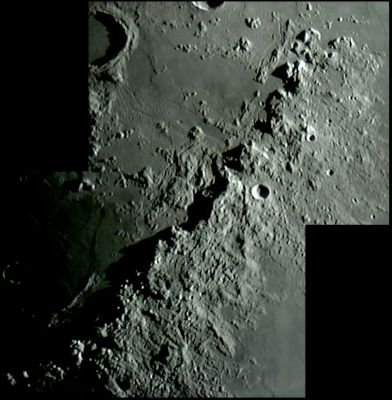Apennine Mts
Contents
Montes Apenninus
(current IAU name; former IAU name: Apennines; informally: Apennine Mountains)
|
Lat: 18.9°N, Long: 3.7°W, Diam: 401 km, Height: 5.4 km, Rükl: 22 |

Tom Bash
Images
LPOD Photo Gallery Lunar Orbiter Images Apollo Images Kaguya HDTV ASU Apollo Image Archive
Maps
(LAC zone 41D3)LAC map Geologic map LM map
Description
Description: Elger
(IAU Directions)THE APENNINES.-- by far the most magnificent range on the visible surface, including as they do some 3000 peaks, and extending in an almost continuous curve of more than 400 miles in length from Mount Hadley, on the north, to the fine ring-plain Eratosthenes, which forms a fitting termination, on the south. The great headland Mount Hadley rises more than 15,000 feet, while a neighbouring promontory on the south-west of it is fully 14,000 feet, and another, close by, is still higher above the Mare. Mount Huygens, again, in N. lat. 20 deg., and the square-shaped mass Mount Wolf, near the southern end of the chain, include peaks standing 18,000 and 12,000 feet respectively above the plain, to which their flanks descend with a steep declivity. The counterscarp of the Apennines, in places 160 miles in width from west to east, runs down to the Mare Vaporum with a comparatively gentle inclination. It is everywhere traversed by winding valleys of a very intricate type, all trending towards the south-east, and includes some bright craters and mountain-rings.
Description: Wikipedia
Additional Information
- Depth data from Kurt Fisher database
- Viscardy, 1985: 5.4 km
- A profile of the Apennines from south of the Apennine Bench to north of Mons Wolff was produced by using LTVT on an amateur photograph. (Boint 2008. "Measuring The Apennine Mountains And Rimae Archimedes [Area]", The Lunar Observer, Feb. 2008. p 4-5; or PDF download).- fatastronomer
- The official position and "diameter" for Montes Apenninus given in the IAU Planetary Gazetteer (and repeated at the top of this page) would have the range extending only from near Eratosthenes to slightly north of Mons Bradley. According to that definition, the region north of that, extending to Promontorium Fresnel, falls within the circle of Montes Haemus. However, the hand-labeled USGS Digital Atlas nearside nomenclature map (which is supposed to document this nomenclature) follows the traditional system with Montes Apenninus being the entire range along the southeast shore of Mare Imbrium and the name Montes Haemus being confined to a relatively minor extension along the southwest shore of Mare Serenitatis. The length of the traditional Montes Apenninus is closer to 580 km than to the value given in the Gazetteer. - JimMosher Jan 7, 2008
Nomenclature
- Named after the terrestrial Apennines .
- Called Riphaeus by Gassendi in the late 1630s (Whitaker, p. 33). The word riphaeus seems most connected with a species of moth from Madagascar; perhaps the Apennines reminded Gassendi of a wing from this moth - pure speculation! - tychocrater Jul 19, 2007
- Note: As intriguing as this speculation may seem, Linnaeus did not introduce his Latin system of animal names until 1735 and this particular moth does not appear to have received its modern name until1773, more than 100 years after Gassendi's death. Gassendi was more likely aware of the classical associations of this name with a mythical mountain range possibly inspired by the Ural range in Asia.
- According to Whitaker (p. 209), of the many names introduced by Hevelius, Mons Apenninus is one of just ten that have survived into modern usage; and one of only four still used at the original location. However, it does not appear in Whitaker's list of names used by Riccioli, so exactly who re-introduced into the mainstream lunar nomenclature (or if Riccioli used it) is unclear. - JimMosher
- In the original IAU Nomenclature of Blagg and Müller (1935) the name was simply Apennines. It was Latinized in IAU Transactions XIIB (1964).
LPOD Articles
Lunar Image of the Week (Apollo Image Archive, Arizona State University)
The Mighty Apennine Mountain Range (09/30/2008)
Lunar 100
L4: Imbrium basin rim.
Bibliography
- Wood, C.A. Mar. 2000. The Apennine Bench. S&T March 2000 v99 p128
- Spudis, P. and J. W. Head (1977). Geology of the Imbrium Basin Apennine Mountains and relation to the Apollo 15 landing site. Proc. Lunar Planet. Sci. Conf. 8th, 2785-2797.
- APOLLO OVER THE MOON; A VIEW FROM ORBIT, Chapter 3: The Terrae (Part 1), Figures 37 and 38.
- The unnamed peak at 23°30' North/ 1°30' East: AOTM, Chapter 3 (Part 1), Figure 42.